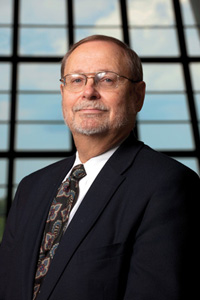Commentary: Dennis Kovar
 |
| Photo: Reidar Hahn, Fermilab |
Particle physics and Americas future
These are extraordinary times for particle physics, remarkable not only for the scientific discoveries that could be in store, but also for the very real opportunities to address critical issues confronting our nation.
We are in the midst of a revolution in the understanding of the very small and the very large. For decades and more, we have been talking about discoveries that may await us when we reach the ultra-high energies of the Terascale. Now we are there. As Fermilabs Tevatron culminates its performance with record luminosities and the Large Hadron Collider begins operations, we have the possibility for discoveries such as extra dimensions and supersymmetry that could fundamentally change our perspective on the universe. If we are fortunate, over the next decade or so we could be in a position to rewrite the textbooks.
We also recognize that future advances will require a new generation of technologies. The detectors and accelerators of tomorrow will need more sensitivity and higher energies, and they must cost less. The quest to develop the tools for future discovery is scarcely less challenging and exciting than the quest for the discoveries themselves.
However, the domain of physicists goes beyond the laboratory and the university. As scientists and citizens, we live in the world and in the midst of recovery from a financial crisis. Economic competitiveness, energy, climate change, and national security are on the front burner for the United States and for countries around the world. In the Department of Energy, the Office of Science has programs positioned to address many of these issues. What is the role of particle physics amid all these challenges?
In fact, the field of particle physics innovates, develops, and drives critical technologies directly applicable to challenges confronting our nation on several fronts. The new Office of Science report, Accelerators for Americas Future (see page 10), describes many of these applications and lays out the potential for future developments with transformative impacts for energy, the environment, medicine, industry, security and defense, and discovery science.

Download the Accelerators for America's Future report or request a printed copy at www.acceleratorsamerica.org
Although created to serve physics, accelerators are by no means any longer the exclusive province of physics. The report estimates that some 30,000 accelerators are now operating worldwide in industry, medicine, and other realms and that $500 billion worth of products are processed, treated, or inspected by particle beams each year.
The federal government invests in basic research largely because of the dividends such investments return for the health, wealth, and security of the nation. As particle physicists, we must deliver great science. We must also demonstrate that investment in particle physics drives innovations in technologies that are essential not only for the future of our own and many other fields of science, but for the well-being of the nation as a whole.
Working in partnership with programs across the Office of Science, we in High Energy Physics can play a leadership role in bringing the science and technology of our field to bear on key national issues. The need and the opportunity have never been greater.
Dennis Kovar is associate director for High Energy Physics in the Department of Energys Office of Science.
Click here to download the pdf version of this article.


